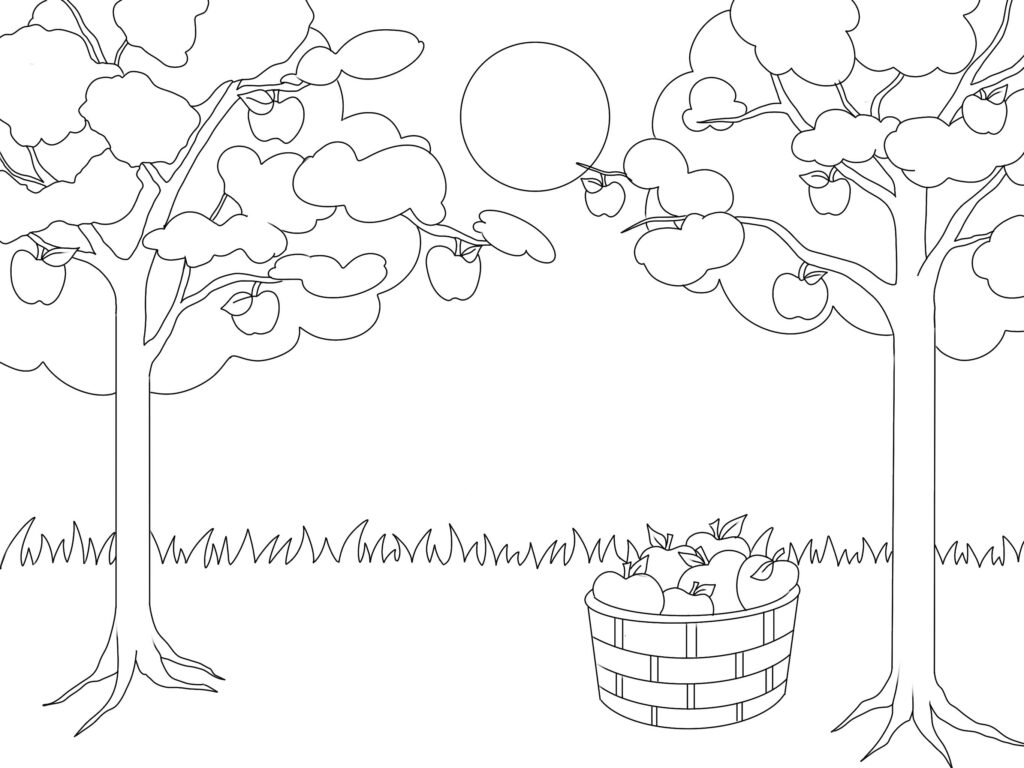Challenge your students to communicate their reasoning as they apply their math skills to respond to these questions related to apple orchards.
Kindergarten – 2nd Grade:
Ask your students to color the image. Then use the image to answer each question.

1. How many apples are in the trees altogether?
2. The basket has 10 apples. How many apples are in the basket that you cannot see?
3. It takes 8 apples to make 1-quart of applesauce. How many quarts of applesauce can be made using the apples in the tree and in the basket? Use words and numbers to support your answer.
3rd – 5th Grade:
1. Betsy has 22 apples and is making apple pies. Each pie needs 6 apples. Betsy claims that she can make 4 apple pies with her apples. Do you agree or disagree with Besty’s claim? Use words and numbers to support your decision.
2. Fred picked 40 apples. He wants to use ½ of the apples to make apple sauce, ¼ of the apples to make apple crisp. Fred plans to use the rest of the apples to make fried apples with cinnamon. How many apples will Fred use to make his fried apples? Use words and numbers to support your answer.
3. The saying “a bushel and a peck” is an expression of love (you might hear this from an older relative). The saying originates from the measurement units of “bushel” and “peck”, which were used in the past to measure apples and other dry goods. A bushel holds approximately 40 pounds of apples. A peck holds 10 pounds of apples. Brian has 2 bushels and 3 pecks of apples. How many pounds of apples does Brian have? Use words and numbers to support your answer.
6th – 8th Grade:
1. The saying “a bushel and a peck” is an expression of love (you might hear this from an older relative). The saying originates from the measurement units of “bushel” and “peck”, which were used in the past to measure apples and other dry goods. One bushel is equal to 4 pecks. Write an equation to represents the number of bushels (b) based on (x) number of pecks.
2. Tuttle Orchard has two sections of apple trees. One section has 15 rows with 10 trees in each. The other section has 8 rows with 12 trees in each. Each tree produces roughly 500 pounds of apples. Mr. Tuttle keeps 10% of the apples to sale to customers who visit the orchard. The rest he sells to a local bakery. The orchard sales the apples to its guest at $2.50 per pound. The bakery gets a discount and only pays $1.75 per pound. What is the total revenue from one year’s apple harvest? Justify your answer.
3. Kevin is selecting new pie dishes for his bakery. Pie dish is in the shape of a cylinder. He wants the dish that will make a thinner pie (less filling) but needs about the same amount of crust. Review the two options.
- Option A: the dish has a radius of 4.5 inches and is 1.5 inches deep
- Option B: the dish has a radius of 4 inches and is 1.75 inches deep
Which option do you recommend Kevin use? Justify your answer.
High School:
Table 1 provides the expected harvest and selling price for three types of apples.
1. Kyle’s Apple Orchard charges $5 for entry plus the cost of the apples each visitor picks. Write an equation to show the total cost (y) for 1 person to enter and pick (x) number of pounds of gala apples.
2. Jason claims that the equation y = 270x can be used to represent the revenue (y) based on (x) number of granny smith apple trees. Do you agree or disagree with Jason’s claim? Justify your decision.
3. Janice makes apple pies using a combination of fuji and granny smith apples. The recipe uses a ratio of 2 granny smith apples for every 1 fuji apple. One apple pie requires 7 fresh apples. Janice has 42 fresh granny smith apples and 20 fuji apples. How many apple pies can Janice make? Justify your answer.

